

Best Beginnings. Supporting you when your baby is sick or premature More than 1 in every 10 UK babies is born prematurely or sick.
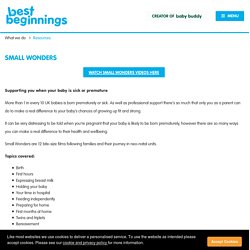
As well as professional support there’s so much that only you as a parent can do to make a real difference to your baby’s chances of growing up fit and strong. It can be very distressing to be told when you’re pregnant that your baby is likely to be born prematurely, however there are so many ways you can make a real difference to their health and wellbeing. 10 cool uses for breastmilk that you probably didn't know about. Photo: Roberto Caruso, Paint Colour: Poolside Blue 2048-40 by Benjamin Moore We all know about the amazing nutritional and immunity-boosting benefits of breastmilk for feeding babies, but what about other surprising practical uses?
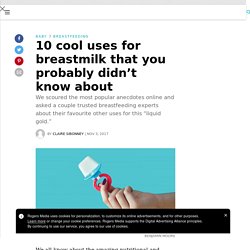
There are some astonishing applications to treat everything from mom’s sore nipples to baby’s goopy eyes. We’re not calling it a cure-all for any ailment (when in doubt, you should always check with your doctor), but if Swedish researchers are trying to kill cancer cells with the stuff, some of these age-old, everyday remedies could be onto something, no? “It’s an incredible, astounding bodily fluid,” says board-certified lactation consultant Shery Leeder. “If in doubt, try it, because it’s not going to hurt, and you might actually stumble upon something that is actually quite helpful.” Here’s a rundown of the most popular and unexpected ways to use breastmilk. 1. Start4Life-Introducing-Solid-Foods-2015.
Sleep. Loving your velcro baby – Pinky McKay Official Website. Newborn behaviour. Gastro oesophageal reflux and the breastfed baby - ABM. Memes. Notes. Partners and breastfeeding - ABM. There are also positive health outcomes for your breastfeeding partner, such as a lower risk of ovarian and breast cancers and osteoporosis and a lower risk of mental health issues. And, of course, breastfeeding costs less, and breast milk is easily portable. Breastfeeding: the basics Breastfeeding works best when we respond to our baby rather than trying to follow a schedule or trying to artificially space out feeds.
Experts now recommend we follow what the baby shows us they need. The more a baby feeds, the more milk the breastfeeding parent will make, so it is best to offer the breast whenever baby shows signs of being hungry. Congratulations, you’re going to be a grandparent - ABM. The Real Reasons Why You Cannot Teach Babies to Self Soothe to Sleep. Vaseline. Thrush detailed information and breastfeeding.
3-Is-this-normal. Is my older baby getting enough milk? By Kelly Bonyata, BS, IBCLC.

Green Poop: When Should You Worry? Normal Color and Consistency Baby’s first stools are the black and tarry meconium that was in her gut at birth.

When breastfeeding is going well, by about the third day, baby’s poop changes to “transitional stools,” which have a dark greenish color. By the fifth day or so, the poop’s color changes again to yellow. Its consistency now (and until baby begins consuming anything other than your milk) may look like split pea soup, liquid with seedy bits in it. But if your baby’s poop is all liquid and no seeds, this is also normal. What the Heck Goes Wrong Sleep Wise at 8-10 Months? One of the most popular blog posts I’ve ever written is all about the 4-5 month sleep regression.

I need to make a confession, I lied a little bit in it. I gave the impression that things get a lot better after six months. And they do. Often though the improvement is only temporary and things can often get a lot, lot worse towards the end of the first year. Once again it is transient, things will get better. When parents are deep in the depths of the 4-5month sleep regression the very last thing they want to hear is that things will get better, but only for a couple of months when they get much worse. So what the heck happens to sleep between eight and ten months of age? Research has shown us that at nine months of age, getting on for two thirds of babies are waking regularly at night, that’s almost twenty percent more than those who wake regularly at six months.
The problem with this is that this is unexpected. In reality however it looks more like this: Sarah Like this: Like Loading... Australian Breastfeeding Association. The thyroid gland The main function of the thyroid gland is to make thyroxine (T4) and triiodothyronine (T3) hormones.
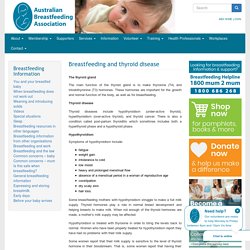
These hormones are important for the growth and normal function of the body, as well as for breastfeeding. Thyroid disease Thyroid diseases include hypothyroidism (under-active thyroid), hyperthyroidism (over-active thyroid), and thyroid cancer. Baby's Second Night. By Jan Barger, RN, MA, IBCLC, FILCA.
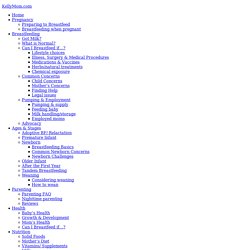
Reprinted with permission from the author. Image courtesy of kit4na / CC BY-2.0 flickr.com You’ve made it through your first 24 hours as a new mom. Maybe you have other children, but you are a new mom all over again… and now it’s your baby’s second night. All of a sudden, your little one discovers that he’s no longer back in the warmth and comfort – though a bit crowded – womb where he has spent the last 9 months – and it is SCARY out here! In fact, each time you put him back on the breast he nurses for a little bit and then goes to sleep. So, what do you do? Another helpful hint… his hands were his best friends in utero… he could suck on his thumb or his fingers anytime he was the slightest bit disturbed or uncomfortable. My Baby Won't Nurse! By Kelly Bonyata, BS, IBCLC Introduction The following techniques have proven helpful for a wide range of problems with baby refusing the breast.
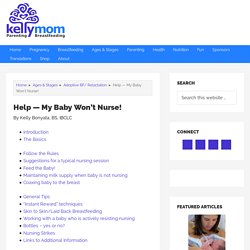
Some of the babies who might benefit include: a newborn (or older adopted baby) trying to figure out how to breastfeeda previously-weaned baby whom you wish to breastfeed againa baby who seriously resists nursing (or even being placed in a nursing position)a baby with nipple confusiona baby who is a fussy nurser (but does not completely refuse the breast)a baby on a nursing strike Even if you have a baby who adamantly resists nursing, getting your baby to breast is very possible but it will probably require time, patience, and kangaroo-style frequency.
Pain in breasts - The Breastfeeding Network. Pain in Nipples - The Breastfeeding Network. Attaching Your Baby at the Breast – Breastfeeding Series. Contraception and breastfeeding. Breastfeeding / Nursing Aversion and Agitation (BAA) What is the phenomenon of Breastfeeding Aversion and Agitation (BAA)?
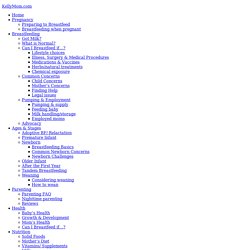
BAA or ‘aversion’ is a phenomenon that some breastfeeding mothers experience, which includes having particular negative feelings, often coupled with intrusive thoughts when an infant is latched and suckling at the breast (Yate, 2017). The two days before I get my period, I get nursing aversion at night. This usually feels like being very agitated, and the need to get my baby off me and what only be described as extreme itching all over my body but under the skin.” –Nadia These feelings are often unexpected, and almost always unwanted, as many mothers who experience aversion would like to continue breastfeeding.
AngerAgitationDisgust/Self-DisgustIrritabilityRageSkin itching/crawlingShame & Guilt (usually afterwards) Image used with permission. Intrusive thoughts are known to occur in motherhood (Kleiman, 2010), but with BAA these appear to be specific to breastfeeding and can include, but are not at all limited to: Hormones. When To Introduce a Bottle To a Breastfed Baby? A few months ago I received a call from a confused mum; her baby was 3 months old, breastfed, and that night he had refused his daily bottle.
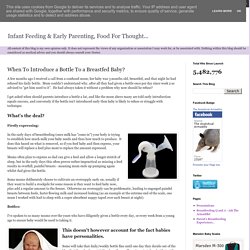
Mum couldn't understand why, after all they had given a bottle once per day since week 2 as advised to "get him used to it". Co-sleeping-and-SIDS-A-Guide-for-Health-Professionals.
Wakeful 4 Month Olds. By Jan Barger, RN, MA, IBCLC, FILCA. Reprinted with permission from the author. Image courtesy of tostadophoto.com / CC BY-2.0 flickr.com One concern about some parenting books and pediatricians/ health care professionals (HCP) who give advice about sleeping infants is this: Baby starts sleeping through the night at, say, about 3 months — or is sleeping 5 to 6 hours instead of 2 to 3. Suddenly around 4 months, little Buford starts waking up at night to nurse. Mom is understandably distressed. Has NO ONE stopped to consider the developmental stage of the breastfeeding baby that begins at about four months and can go on to 6 or 7 months?
When I get one of these babies in my office, I have to observe the feed without saying a word to the mother. But WAIT! Help – My 4-5 Month Old Is Sleeping Like a Newborn Again (AKA ‘The 4-5 month ... If you asked me what point of parenting I found the hardest (excluding tweenhood, because that’s a WHOLE other ball game, whoah have you got fun to come!) It would have to be 4 and 5 months. I’ve always found the newborn period pretty easy, I think in part to the hideous morning sickness, PGP and insomnia I experience during pregnancy meaning that even 3hrs of broken sleep at night is an improvement on my pregnancy sleep, plus you get lots of lovely warm squishy cuddles and an immobile baby who’s content with his or her world revolving around your chest not needing anything else.
So what happens at 4 and 5 months? You’ve just settled into a routine, both day and night. Your little one may be sleeping stretches of 4 or 5 hours at night (or if you’re lucky, even longer!) The Breastfeeding Network Drugs in Breastmilk information service - Home. How do you treat a milk blister? By Kelly Bonyata, BS, IBCLC What is a milk blister? A milk blister, or blocked nipple pore, is also called a bleb or nipple blister, or simply “milk under the skin.”
It occurs when a tiny bit of skin overgrows a milk duct opening and milk backs up behind it. A milk blister usually shows up as a painful white, clear or yellow dot on the nipple or areola (see photo), and the pain tends to be focused at that spot and just behind it. If you compress the breast so that milk is forced down the ducts, the blister will typically bulge outward. This is not the same as a blister on the nipple caused by friction. A white spot on the nipple may also be caused by an obstruction within the milk duct (as opposed to skin covering the milk duct). Lopsided! What can I do? …When baby prefers one side, or when supply or breast size is greater on one side By Kelly Bonyata, BS, IBCLC Is this a problem? Most women notice differences in milk supply, pumping output, milk flow and/or size between breasts. As with many other things (foot size, ring size, eyesight, etc.) asymmetry is normal in humans.
What feeding positions work if I'm large breasted? Can a nursing mother eat this food? FAQs. With Large Breasts - Breastfeeding Support. Alternatives To Bottles. Can I Overfeed My Breastfed Baby? Engorgement Help: Reverse Pressure Softening. Reverse Cycling. By Kelly Bonyata, BS, IBCLC. How to gently night wean a breastfed baby or toddler. The Night Boob! How To Gently Night Wean Your Toddler From Breastfeeding And ... Breastfeeding to awake! 3. Nipple Vasospasm and Breastfeeding - Breastfeeding Support.
Night Weaning. By Kelly Bonyata, IBCLC, Becky Flora, IBCLC and Paula Yount. Breast Compression Teaching Video. Why Do Milk Storage Guidelines Differ?